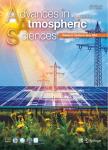The Interannual Variability of East Asian Winter Monsoon and Its Relation to the Summer Monsoon
The Interannual Variability of East Asian Winter Monsoon and Its Relation to the Summer Monsoon作者机构:Institute of Atmospheric Physics Chinese Academy of Sciences China Max-Planck-Institute of Meteorology Hamburg Germany
出 版 物:《Advances in Atmospheric Sciences》 (大气科学进展(英文版))
年 卷 期:2000年第17卷第1期
页 面:48-60页
核心收录:
学科分类:07[理学] 070601[理学-气象学] 0706[理学-大气科学]
基 金:National Key Programme for Developing Basic Sciences, (G1998040900, KZ 952-S 1-404) Academia Sinica Chinese Academy of Sciences, CAS
主 题:East Asian winter monsoon Interannual variability SST Summer monsoon
摘 要:Based on the NCEP/ NCAR reanalysis data the interannual variability of the East Asian winter mon-soon (EAWM) is studied with a newly defined EAWM intensity index. The marked features for a strong (weak) winter monsoon include strong (weak) northerly winds along coastal East Asia, cold (warm) East Asian continent and surrounding sea and warm (cold) ocean from the subtropical central Pacific to the trop-ical western Pacific, high (low) pressure in East Asian continent and low (high) pressure in the adjacent ocean and deep (weak) East Asian trough at 500 hPa. These interannual variations are shown to be closely connected to the SST anomaly in the tropical Pacific, both in the western and eastern Pacific. The results suggest that the strength of the EAWM is mainly influenced by the processes associated with the SST anom-aly over the tropical Pacific. The EAWM generally becomes weak when there is a positive SST anomaly in the tropical eastern Pacific (El Ni?o), and it becomes strong when there is a negative SST anomaly (La Ni?a). Moreover, the SST anomaly in the South China Sea is found to be closely related to the EAWM and may persist to the following summer. Both the circulation at 850 hPa and the rainfall in China confirm the connection between the EAWM and the following East Asian summer monsoon. The possible reason for the recent 1998 summer flood in China is briefly discussed too. Key words East Asian winter monsoon - Interannual variability - SST - Summer monsoon This study was supported by “ National Key Programme for Developing Basic Sciences G1998040900 part 1, and by key project (KZ 952-S1-404) of Chinese Academy of Sciences.



